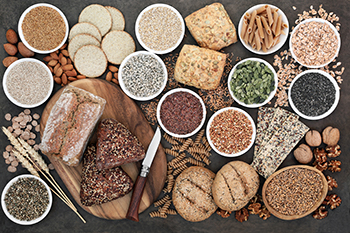More Health and Nutrition Bites
Related
Slim Your Waist with Whole Grains and Legumes
I've said for years that the most important factor in weight loss is the number of calories you eat versus the number of calories you burn. That said, we also know that some foods are more filling and satisfying than others, which is just one explanation for why those who eat more whole grains tend to gain less weight over the years.
Whole wheat reduces inflammation
In the last few years carbohydrates have taken a beating in the popular press, demonized by proponents of Atkins and other fad diets so thoroughly that even dietitians (who should know better) talk about how to make food choices in order to avoid eating them.
Whole grain pasta is more satisfying
We know that more fiber in your diet is great for you: it helps improve cholesterol scores, reduces your risk of colorectal cancer, and helps reduce your risk of diabetes.
Health & Nutrition Bites
Get the latest health and diet news - along with what you can do about it - sent to your Inbox once a week. Get Dr. Gourmet's Health and Nutrition Bites sent to you via email. Sign up now!
Whole grains better for your heart - and waist - than fruits and vegetables

They are three of the nine components of the Mediterranean Diet: whole grains, fruits and nuts, and vegetables. To receive a point in your Mediterranean Diet score for each of these items you must consume, on average (for women): 4.5 servings of whole grains (the equivalent of 8 slices of whole wheat bread or 4.5 2-ounce servings of whole grain pasta), 9 ounces of vegetables per day (about 3 cups of broccoli, total), and 8 ounces of fruit or nuts per day (about 2 medium bananas or 1 cup nuts).
Whole grains, fruits, and vegetables are all good sources of fiber, and higher fiber has been linked with greater satiety - meaning people are more satisfied and less likely to consume more food after consuming a high-fiber meal than if they had consumed a lower-fiber meal.
We've also seen that higher fiber intake is linked to better cholesterol scores as well as a slimmer waist, which means a more favorable Waist to Hip Ratio, another important indicator of overall health risk.
An international group of researchers designed a feeding trial to find out whether emphasizing whole grains, fruits and vegetables, or both together might yield larger improvements in metabolic scores as well as waist circumference or overall weight loss.
To find out, they recruited women ages 18-50 who were clinically overweight but without other chronic diseases like diabetes or high blood pressure to participate in their feeding study.
The study randomly assigned the 75 eligible participants to follow 1 of 3 diets for 10 weeks, proceeding to follow each of three diets for 10 weeks each in random order. The diets were described as designed to reduce calories for modest weight loss in each participant, while also emphasizing either whole grains, fruits and vegetables, or both, as follows:
Whole grains diet: consumed 25g of fiber/day from whole grain products and 10g fiber/day from fruits and vegetables
Fruits and Vegetables diet: consumed 25g fiber/day from fruits and vegetables and 10g fiber/day from whole grains; and
Both: an equal amount of fiber from both whole grains and fruits and vegetables: 17.5g each/day.
The authors subjected the participants to blood tests and body measurements as well as weighing them before and after each 10-week period.
It's important to note that all three diets are a little higher in fiber than that recommended by the American Heart Association. That organization recommends 25 grams of fiber per day for a 2,000 calorie-per-day diet, while most of these women's daily caloric intake was closer to 2,200 calories per day.
After the women had completed all three arms of the trial, the authors compared the changes in weight, waist circumference, and metabolic scores.
They found that while on the diet that emphasized whole grains, the women lost more weight, decreased their waist circumference more, improved their systolic blood pressure more, and lowered their triglycerides more while increasing their HDL cholesterol more than they did while following either of the other diets.
What this means for you
This does not mean that you can safely ignore fruits and vegetables in favor of eating more whole grain foods like whole grain pasta, pizza made with whole wheat crust, or pretzels from a bag labeled "WHOLE GRAIN".
These participants were on a reduced-calorie diet that emphasized (in excess of current recommendations, even), but did not eliminate other sources of fiber. As a long-term strategy you should make more of an effort to switch to whole grains across the board in order to have a greater effect on your metabolic health, but fruits and vegetables are still important and are great sources of antioxidants and other nutrients: a balanced diet is still the most sustainably healthful diet.
First posted: June 5, 2019
